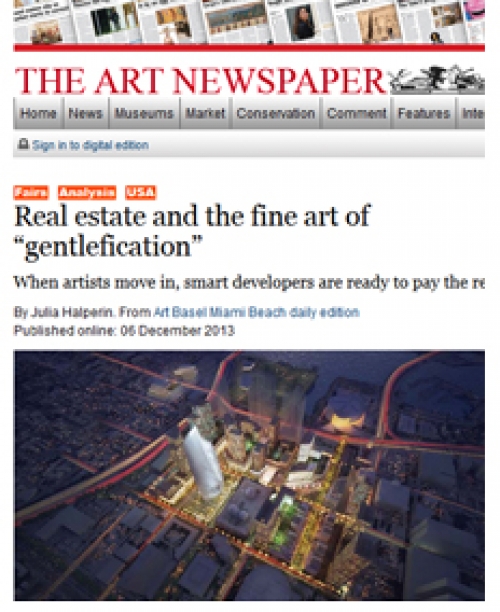
The Art Newspaper
Real Estate and The Fine Art of “Gentlefication”
Julia HalperinWhen artists move in, smart developers are ready to pay the rent.
The city’s Design District, once an eclectic neighbourhood dominated by furniture showrooms and artist studios, is in the middle of a billion-dollar transformation into a luxury retail hub. By 2015, around 100 new stores, including Armani, Louis Vuitton and Valentino are scheduled to open in the area. Although many of the original design showrooms are expected to remain in place, most of the district’s studios, galleries and art non-profits have already moved downtown or further north.
“We knew we had a finite amount of time there—there were zero hard feelings,” says the artist Jim Drain, who worked in the Design District for six years. His building was demolished two years ago to clear the way for cutting-edge constructions by architects such as Sou Fujimoto and Keenan Riley and permanent public art projects by John Baldessari and Nate Lowman.
Like most of the artists in the area, Drain received his studio rent-free from the developer Craig Robins, the driving force behind the current development. Robins co-owns 70% of the district’s property with the investment group L Real Estate. In exchange, Drain and the dozen other artists held monthly community events to draw creative people to the district.
“I always try to mix people involved in design and art because it gives a certain spirit to a neighbourhood,” Robins says. Tony Goldman, a prominent developer of the nearby Wynwood district, adopted a similar model, which he called “gentlefication”.
The tactic has worked. Since artists started moving into both neighbourhoods 15 years ago, rents have risen from less than $10 per foot “to triple digits” per foot, says the real estate executive Stephen Bittel. Prices for warehouse space in Wynwood have more than doubled since 2009, according to the dealer Joe Amrein, who co-organises the Miami art fair Seven.
Artists are now moving out of Wynwood and the Design District in search of more affordable space. Developers in Little Haiti and Little River, located north of the Design District, as well as in downtown Miami, are eager to take them in. Over the past 18 months, 50 artist studios have opened downtown, according to the Downtown Development Authority. “There’s an almost miraculously enlightened, progressive attitude in Miami held by civil leaders about the power artists have to positively transform neighbourhoods,” says Michael Spring, the cultural affairs director of Miami-Dade County.
For decades, artists have helped attract real-estate development to parts of Miami, not to mention cities all over the world. But “now it is more of a deliberate strategy”, Spring says. Developers are consulting with curators and seeking out artists directly. Twelve of the 18 artists surveyed by The Art Newspaper said they received free studio or exhibition space from a developer in Miami.
Even some of the city’s largest real estate initiatives are starting to make room for artists. The Miami Worldcenter is a 25-acre mixed-use development near the new Pérez Art Museum downtown. Last year, it invited 16 artists and galleries, including Dimensions Variable and Primary Space, to work in 35,000 sq. ft of empty warehouse space. (Only a few pay rent, marked down from the $20 sq. ft market rate.)
“People like Craig Robins and Tony Goldman showed the value of having artists involved in neighbourhoods over time,” says Nitin Motwani, the managing director of Miami Worldcenter.
The artists understand that the arrangement may be temporary but are flattered by the attention. “It is an honour to think that community developers are paying attention to art,” says Tasha López De Victoria, who moved into a Worldcenter-owned space last year with Jim Drain, Naomi Fisher and other prominent local artists.
However, some in Miami’s cultural community question whether these arrangements will truly benefit artists in the long term. “I want an option for my artists that is not studio hopping every two or three years and being at the mercy of someone else’s generosity,” says the Miami gallerist Nina Johnson-Milewski.
Others worry that the lightning speed of development is preventing artists from building stable communities. The artist Antonia Wright was recently offered twice what she paid only a year-and-a half ago for her studio in Little River.
“Currently, it’s an artificial cycle that moves so fast that it hardly allows for any community to develop organically and honestly,” says the artist Carlos Betancourt.
But these long-term concerns are unlikely to dissuade artists from accepting inexpensive workspace in a convenient neighbourhood any time soon. “Art and real estate are like sisters in a lot of ways,” says Jim Drain. “Part of being an artist is finding lots of room for as little money as possible.”
